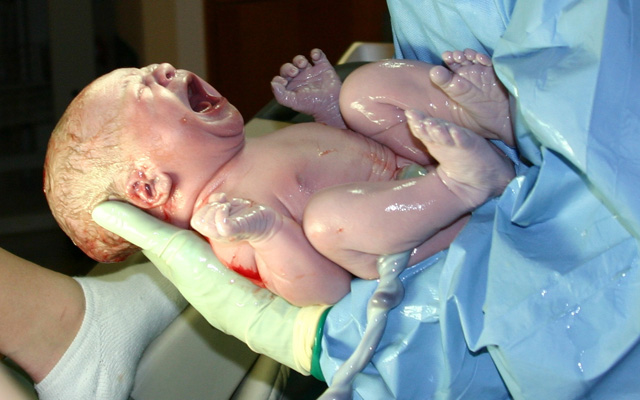Vaginal Microbes Can Be Partially Restored to C-Section Babies
First direct evidence that simply transferring vaginal fluids from mother to newborn modifies a baby's microbiome
Published Date
By:
- Heather Buschman
Share This:
Article Content

A newborn baby. Photo by Ernest F.
In a small pilot study, researchers at University of California, San Diego School of Medicine and Icahn School of Medicine at Mount Sinai determined that a simple swab to transfer vaginal microbes from a mother to her C-section-delivered newborn can alter the baby's microbial makeup (microbiome) in a way that more closely resembles the microbiome of a vaginally delivered baby.
The study is published February 1, 2016 by Nature Medicine.
Babies delivered by C-section differ from babies delivered vaginally in the makeup of the microbes that live in and on their bodies. These early microbiomes help educate the baby’s developing immune system. Previous research suggests a link between C-section delivery and increased subsequent risk of obesity, asthma, allergies, atopic disease and other immune deficiencies. Many of these diseases have also been linked to the microbiome, though the role a newborn’s microbiome plays in current or long-term health is not yet well-understood.
“When my own child was born by unplanned C-section, we took matters into our own hands to see to it that she was exposed to vaginal microbes,” said Rob Knight, PhD, professor of pediatrics, computer science and engineering, and director of the Center for Microbiome Innovation at UC San Diego. “She is now four years old and healthy, but that was an uncontrolled experiment of one and so we can’t tell whether it had an effect from a scientific perspective. This study now starts to prove that the effect exists, telling us that some of those vaginal microbes probably do stick around when transferred to a baby born by C-section, at least for the first month of life. Other research suggests that microbiome differences between vaginal and C-section babies can persist for years.”
Knight led the current study with first author Maria Dominguez-Bello, PhD, New York University and University of Puerto Rico, and senior author Jose Clemente, PhD, Icahn School of Medicine at Mount Sinai, who started working on the project while a postdoctoral fellow in Knight’s lab.
In the study, the researchers collected samples from 18 infants and their mothers, including seven born vaginally and 11 delivered by scheduled C-section. Of the C-section-delivered babies, four were exposed to their mothers’ vaginal fluids at birth as part of this study. To do this, sterile gauze was incubated in the mothers’ vaginas for one hour before the C-section. Within two minutes of their birth, the babies delivered by C-section were swabbed with the gauze starting with the mouth, then the face and the rest of the body.
Six times over the first month after birth, the researchers collected a total of 1,519 anal, oral and skin samples from the mothers and infants. Knight’s team then used a gene sequencing technique to map the types and relative quantities of bacterial species present at each body site.
Here’s what they found: the microbiomes of the four C-section-delivered infants exposed to vaginal fluids more closely resembled those of vaginally delivered infants than unexposed C-section-delivered infants, though the difference was more distinct in their oral and skin samples than in their anal samples. This partial microbial restoration could be due to the fact that the infants received only one surface application of maternal vaginal fluids, Knight said.
Yet the oral and skin microbiome differences between C-section-delivered infants who received the microbial transfer and those who did not was still noticeable one month after birth. The results were not due to diet differences, as all of the infants received breast milk either exclusively or supplemented with formula during the first month of life. In addition, consistent with previous studies, the babies’ microbiome profiles did not correlate with the amount of breast milk they received.
In follow-up research, the scientists want to determine if it matters how and when vaginal fluids are transferred to a newborn, how long the microbial differences last and how microbial exposure at birth affects a person’s long-term health or susceptibility to disease.
“The present work is a pilot study — we need substantially more children and a longer follow-up period to connect the procedure to health effects,” said Knight, who credits his family’s personal experience as part of the reason he relocated his research team to the Department of Pediatrics at UC San Diego School of Medicine. “This study points the way to how we would do that, and provides the proof-of-concept that microbiome modification early in life is possible. In fact, we already have more than 10,000 additional samples collected as part of this study that still await analysis.”
The research team is seeking additional funding support to expand the project.
Share This:
Stay in the Know
Keep up with all the latest from UC San Diego. Subscribe to the newsletter today.



